NVIDIA GeForce GTX 780 Review: The New High End
by Ryan Smith on May 23, 2013 9:00 AM ESTCompute
Jumping into compute, we should see a mix of results here, with some tests favoring the GK110 based GTX 780’s more compute capable design, while other tests will punish it for not being a fast FP64 card like GTX Titan.
As always we'll start with our DirectCompute game example, Civilization V, which uses DirectCompute to decompress textures on the fly. Civ V includes a sub-benchmark that exclusively tests the speed of their texture decompression algorithm by repeatedly decompressing the textures required for one of the game’s leader scenes. While DirectCompute is used in many games, this is one of the only games with a benchmark that can isolate the use of DirectCompute and its resulting performance.
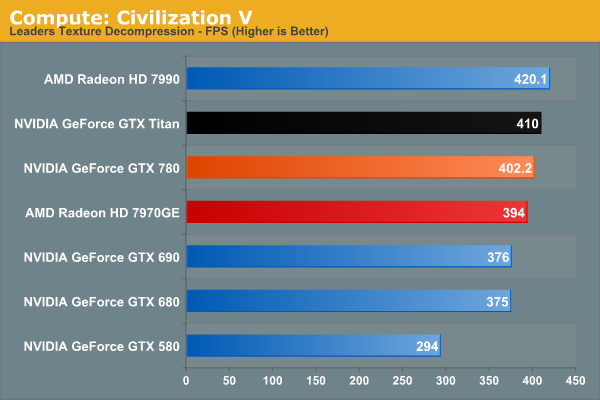
Civilization V’s DirectCompute performance is looking increasingly maxed out at the high end. At 402fps the GTX 780 may as well be tied with GTX Titan. On the other hand it’s a reminder that while we don’t always see NVIDIA do well in our more pure compute tests, it can deliver where it matters for games with DirectCompute.
Our next benchmark is LuxMark2.0, the official benchmark of SmallLuxGPU 2.0. SmallLuxGPU is an OpenCL accelerated ray tracer that is part of the larger LuxRender suite. Ray tracing has become a stronghold for GPUs in recent years as ray tracing maps well to GPU pipelines, allowing artists to render scenes much more quickly than with CPUs alone.
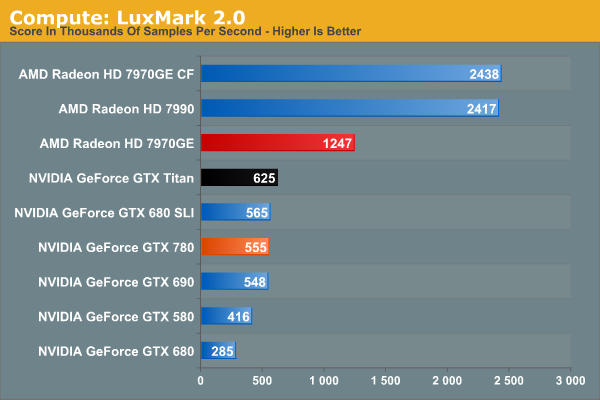
NVIDIA has never done well at LuxMark, and GTX 780 won’t change that. It’s greatly faster than GTX 680 and that’s about it. Kepler parts, including GK110, continue to have trouble with our OpenCL benchmarks, as evidenced by the fact that GTX 780 doesn’t beat GTX 580 by nearly as much as the generational improvements should lead to. GK110 is a strong compute GPU, but not in ways that LuxMark is going to benefit.
Our 3rd benchmark set comes from CLBenchmark 1.1. CLBenchmark contains a number of subtests; we’re focusing on the most practical of them, the computer vision test and the fluid simulation test. The former being a useful proxy for computer imaging tasks where systems are required to parse images and identify features (e.g. humans), while fluid simulations are common in professional graphics work and games alike.
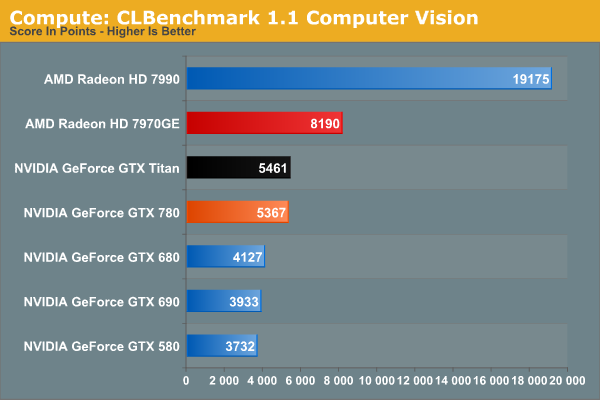
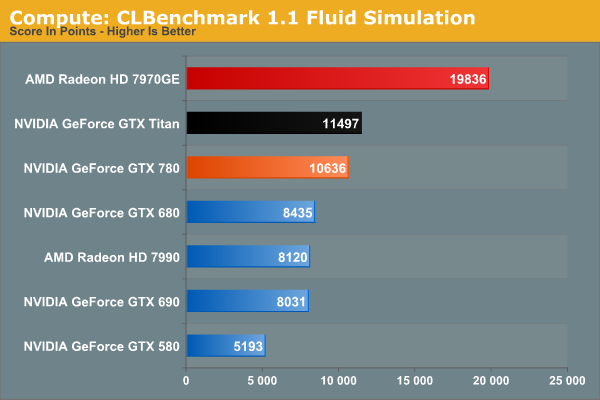
GTX 780 still struggles some at compute with CLBenchmark, but less so than with LuxMark. 7970GE is the clear winner here in both tests, while GTX 780 stays remarkably close to GTX Titan in performance. The fluid simulation in particular makes GTX 780 look good on a generational basis, more than doubling GTX 580’s performance.
Moving on, our 4th compute benchmark is FAHBench, the official Folding @ Home benchmark. Folding @ Home is the popular Stanford-backed research and distributed computing initiative that has work distributed to millions of volunteer computers over the internet, each of which is responsible for a tiny slice of a protein folding simulation. FAHBench can test both single precision and double precision floating point performance, with single precision being the most useful metric for most consumer cards due to their low double precision performance. Each precision has two modes, explicit and implicit, the difference being whether water atoms are included in the simulation, which adds quite a bit of work and overhead. This is another OpenCL test, as Folding @ Home has moved exclusively to OpenCL this year with FAHCore 17.

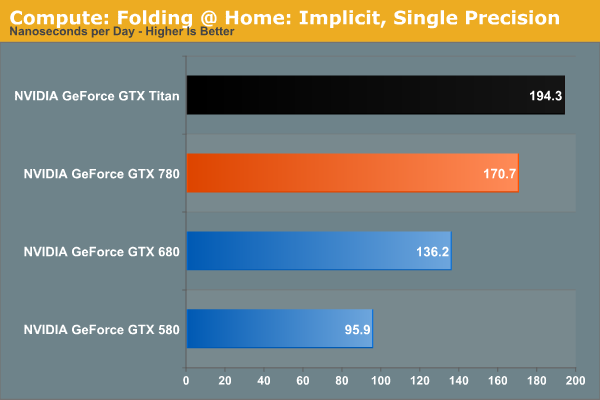
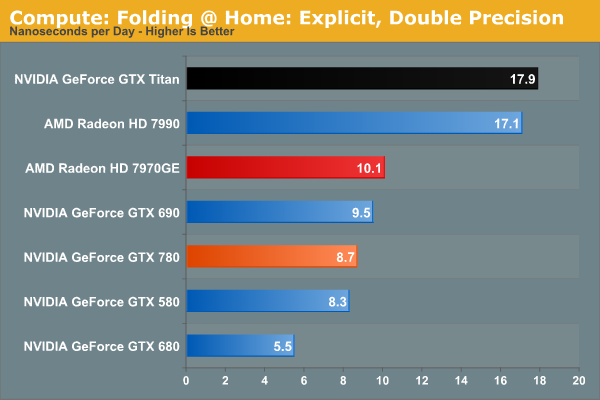
The Folding@Home group recently pushed out a major core update(FAHBench 1.2.0), which we’ve rerun on a number of cards and is reflected in our results. Unfortunately this version also broke single precision implicit on AMD GPUs and AMD’s latest drivers, so we only have NVIDIA GPUs for that section.
In any case, despite the fact that this is an OpenCL benchmark this is one of the cases where NVIDIA GPUs do well enough for themselves in single precision mode, with GTX 780 surpassing 7970GE, and falling behind only GTX Titan and the 7990. GTX 780 doesn’t necessarily benefit from GK110’s extra compute functionality, but it does see a performance improvement over GTX 680 that’s close to the theoretical difference in shader performance. Meanwhile in double precision mode, the lack of an uncapped double precision mode for GTX 780 means that it brings up the bottom of the charts compared to Titan and its 1/3 FP64 rate. Compute customers looking for a bargain NVIDIA card (relatively speaking) will need to stick with Titan.
Wrapping things up, our final compute benchmark is an in-house project developed by our very own Dr. Ian Cutress. SystemCompute is our first C++ AMP benchmark, utilizing Microsoft’s simple C++ extensions to allow the easy use of GPU computing in C++ programs. SystemCompute in turn is a collection of benchmarks for several different fundamental compute algorithms, as described in this previous article, with the final score represented in points. DirectCompute is the compute backend for C++ AMP on Windows, so this forms our other DirectCompute test.
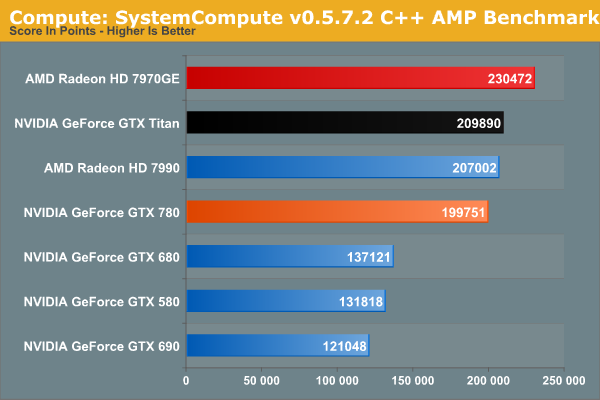
SystemCompute shows very clear gains over both the GTX 680 and GTX 580, while trailing the GTX Titan as expected. However like Titan, both trail the 7970GE.










155 Comments
View All Comments
Stuka87 - Thursday, May 23, 2013 - link
Not for the 780 they don't. There are some cards that have Duke Nukem Forever (lol) and some that have Metro: Last Light. But nothing like what AMD offers.chizow - Thursday, May 23, 2013 - link
Metro was not listed when I checked today, EVGA in the past has done their customers right by sending them codes, but not always, depends how tightly Nvidia controls the promotion.jonjonjonj - Thursday, May 23, 2013 - link
i want free games. wah wah wah. screw free games. i would rather a cheaper more competitively price card then get some game i don't even want.Homeles - Thursday, May 23, 2013 - link
I really like the "Delta Performances" method of comparing the smoothness between each card.hero1 - Thursday, May 23, 2013 - link
This is one awesome card. I really don't think that AMD can compete with Nvidia atm but I would like to see what they have to offer. I want this card but I will be buying the custom cooled ones due to better cooling. Thanks for an awesome review, I have been waiting patiently, not!formulav8 - Friday, May 24, 2013 - link
I haven't seen anything even close to dire for AMD that they should all that worried about. Unless I missed something?mayankleoboy1 - Thursday, May 23, 2013 - link
$649 ?Move along, nothing to do here.
EzioAs - Thursday, May 23, 2013 - link
That was my original plan, but I ended up reading the article. Ahh, curiosity...Spoelie - Thursday, May 23, 2013 - link
The paragraph on SMXs and GPCs is confusing without the information available from the original Titan piece. One has to remember or infer that Titan already had an SMX disabled, and that in fact GK110 has 15 SMXs built in. This conclusion is also non-obvious because the text before discussed there were no disabled functional units in *most* product tiers.Otherwise the reduction from 14 SMXs to 12 SMXs would imply 2 disabled clusters, not 3.
chaosbloodterfly - Thursday, May 23, 2013 - link
Waiting to see what AMD has for the 8970. Hopefully they don't do what nVidia did for the 680 and release something with barely better performance with almost zero pricing pressure 6 months later.I want something worth liquid cooling damn it!